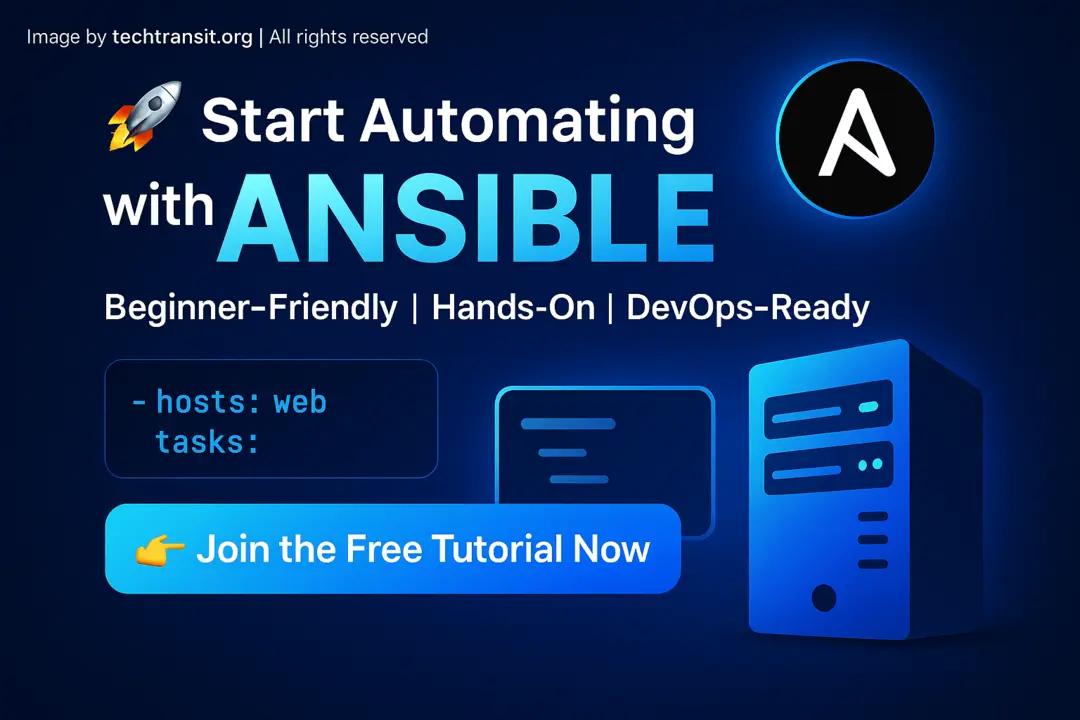
In this tutorial, I’ll guide you through Ansible for the absolute beginner, based on my own learning path, mistakes, and eventually, real-world automation wins. This isn’t a copy-paste guide. It’s a practical, step-by-step walkthrough meant to help you use Ansible in your DevOps workflow, with clarity and confidence.
Why Ansible? Why Now?
As infrastructure grows more complex, configuration management tools are essential. Among them, Ansible stands out for its simplicity and power, especially for beginners.
- No agent installation needed
- Written in human-readable YAML
- Works over SSH
- Scales from one server to thousands
Whether you’re managing a home lab or deploying a production cluster, Ansible saves time and prevents human error. And it plays nicely with tools like Git, Jenkins, and Docker.
Who This Is For
This tutorial is built for:
- Absolute beginners with zero Ansible experience
- DevOps learners are trying to automate tasks
- Sysadmins are tired of repetitive setups
- Developers curious about infrastructure-as-code
- No fancy lab setup needed — just your laptop, a few VMs or cloud servers, and some curiosity.
My Journey: Learning the Hard Way
I started noticing something while browsing freelancing platforms — more and more clients were asking for automation, infrastructure management, and configuration tools. And one name kept popping up: Ansible. Back then, I had no hands-on experience with it. But I knew if I wanted to stay relevant and land better projects, I had to learn. So I dived into it on my own, starting from scratch — reading docs, watching tutorials, and following scattered examples.
Eventually, I earned my Ansible certification, but that wasn’t the hardest part.
When I first touched Ansible, I underestimated it. I thought, “How hard can writing a YAML file be?”
But it wasn’t about syntax — it was about thinking in automation. That mindset shift took time.
I broke things. Rebuilt them. Broke them again. But that trial-and-error process is exactly what helped me learn it for real.
Here you’ll find no theory dumps — just hands-on examples, I will try to provide real automation patterns, and lessons I wish someone had handed me earlier. Everything here is tested, applied, and proven in real freelance and DevOps environments.
Coming Soon!
The Ansible course is in progress. Right now, you’ll see only the table of contents with some hyperlink urls , but I’ll be adding full tutorials and step-by-step guides shortly. Stay tuned for updates!
Recommended Video Courses for You
If you prefer watching and learning instead of reading blog articles, check out these highly-rated courses that can help you level up your skills:
Click here to explore my recommended courses →
Table of Contents
Introduction to Ansible and DevOps
- What is Ansible, and why use it in DevOps?
- Benefits of Ansible for SysAdmins, Developers, and DevOps Engineers
- How Ansible fits into CI/CD and Infrastructure as Code
Environment Setup
- Installing Ansible on Ubuntu
- Installing Ansible on CentOS / RHEL like OS
- Install Ansible Navigator Tool
- Setting up a test lab with VMs or cloud instances
- SSH setup for remote node access
Ansible Basics
- Understanding inventory files
- YAML basics (used in playbooks)
- The Ansible command-line structure
First Hands-on Playbook
- Writing your first Ansible playbook
- Using ad-hoc commands
- Testing with the ping module
- Running a playbook against localhost or a remote server
Modules, Variables, and Facts
- Commonly used Ansible modules (copy, command, service, user, etc.)
- Gathering system facts
- Using variables in playbooks
Conditionals, Loops, and Handlers
- When conditions and looping over lists
- Handlers and the notification mechanism
- Creating idempotent playbooks
Roles and Reusability
- Folder structure of roles
- Creating and using roles
- Best practices for role development
Ansible Vault and Security
- Encrypting secrets using
ansible-vault - Managing credentials securely
Real-World Use Cases
- Automating NGINX/Apache deployment
- Managing users and SSH keys
- Applying security hardening on Linux servers
Common Errors and Troubleshooting
- SSH connection issues
- Inventory syntax problems
- Module not found / Playbook fails
Advanced Concepts (Optional for Beginners)
- Dynamic inventory
- Ansible Tower / AWX
- Integration with Jenkins or CI tools
Bonus: Interview Questions or Certification Tips
- Beginner-friendly DevOps/Ansible questions
- Career insights and learning path
Downloadable Resources / GitHub Link
- Sample playbooks
- Inventory templates
- Cheatsheets
Want to go further with Ansible?
Below are some of the top-rated Ansible courses on Udemy, handpicked for their quality, reviews, and real-world teaching. These video tutorials are great if you prefer structured, step-by-step learning with practical examples.
Ansible for the Absolute Beginner – Hands-On – DevOps
This course introduces Ansible to the absolute beginner in DevOps. Practice Ansible with coding exercises in browser.
Level: Beginner Level
Check It Out →Ansible Advanced – Hands-On – DevOps
Learn and practice advanced topics in Ansible including Roles, Jinja2, Lookups, Filter. Learn to develop custom modules.
Level: Intermediate to Advanced
Check It Out →Dive Into Ansible – Beginner to Expert in Ansible – DevOps
Learn Ansible DevOps + Automation with a Docker Captain! Latest Ansible (2024 v10.x) + Full Browser Lab Included!
Level: Beginner to Expert
Check It Out →Complete DevOps Ansible Automation Training
A complete Ansible course designed for IT professionals and DevOps engineers to automate routine tasks in Linux (RHCE)
Level: ALL Level
Check It Out →



